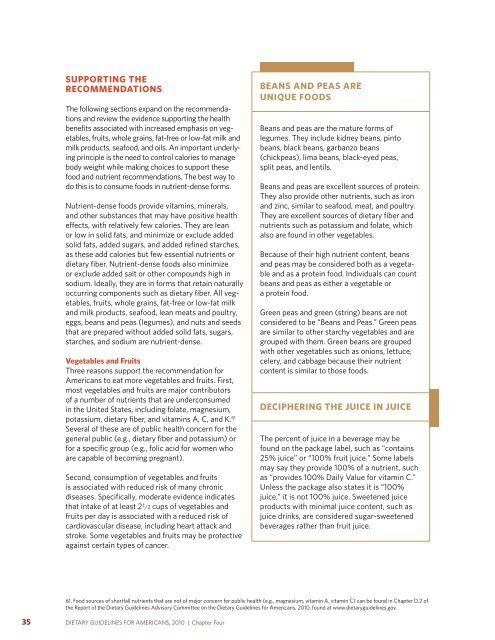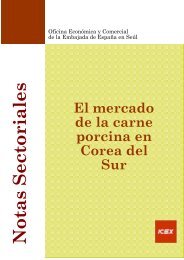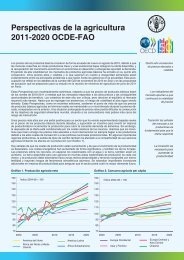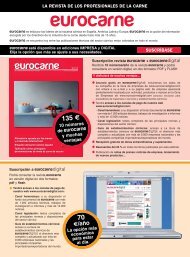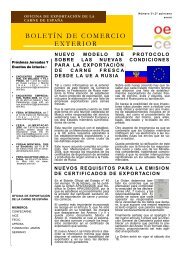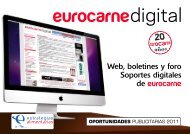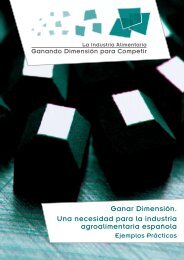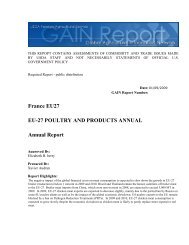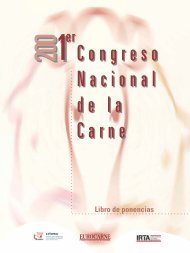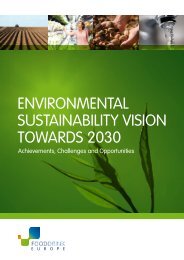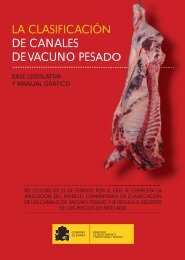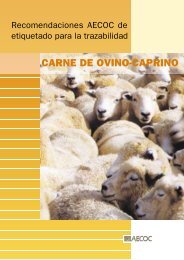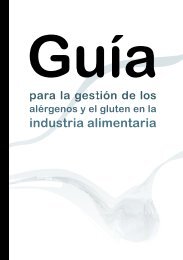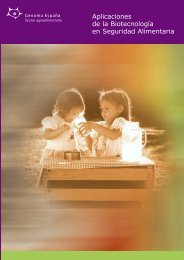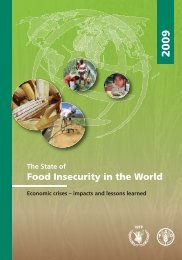Dietary Guidelines for Americans - SchoolNutritionAndFitness.com
Dietary Guidelines for Americans - SchoolNutritionAndFitness.com
Dietary Guidelines for Americans - SchoolNutritionAndFitness.com
- No tags were found...
Create successful ePaper yourself
Turn your PDF publications into a flip-book with our unique Google optimized e-Paper software.
suPPorting therecoMMendationsThe following sections expand on the re<strong>com</strong>mendationsand review the evidence supporting the healthbenefits associated with increased emphasis on vegetables,fruits, whole grains, fat-free or low-fat milk andmilk products, seafood, and oils. An important underlyingprinciple is the need to control calories to managebody weight while making choices to support thesefood and nutrient re<strong>com</strong>mendations. The best way todo this is to consume foods in nutrient-dense <strong>for</strong>ms.Nutrient-dense foods provide vitamins, minerals,and other substances that may have positive healtheffects, with relatively few calories. They are leanor low in solid fats, and minimize or exclude addedsolid fats, added sugars, and added refined starches,as these add calories but few essential nutrients ordietary fiber. Nutrient-dense foods also minimizeor exclude added salt or other <strong>com</strong>pounds high insodium. Ideally, they are in <strong>for</strong>ms that retain naturallyoccurring <strong>com</strong>ponents such as dietary fiber. All veg-etables, fruits, whole grains, fat-free or low-fat milkand milk products, seafood, lean meats and poultry,eggs, beans and peas (legumes), and nuts and seedsthat are prepared without added solid fats, sugars,starches, and sodium are nutrient-dense.vegetables and fruitsThree reasons support the re<strong>com</strong>mendation <strong>for</strong><strong>Americans</strong> to eat more vegetables and fruits. First,most vegetables and fruits are major contributorsof a number of nutrients that are underconsumedin the United States, including folate, magnesium,potassium, dietary fiber, and vitamins A, C, and K. 61Several of these are of public health concern <strong>for</strong> thegeneral public (e.g., dietary fiber and potassium) or<strong>for</strong> a specific group (e.g., folic acid <strong>for</strong> women whoare capable of be<strong>com</strong>ing pregnant).Second, consumption of vegetables and fruitsis associated with reduced risk of many chronicdiseases. Specifically, moderate evidence indicatesthat intake of at least 21/2 cups of vegetables andfruits per day is associated with a reduced risk ofcardiovascular disease, including heart attack andstroke. Some vegetables and fruits may be protectiveagainst certain types of cancer. Beans and Peas areunique foodsBeans and peas are the mature <strong>for</strong>ms oflegumes. They include kidney beans, pintobeans, black beans, garbanzo beans(chickpeas), lima beans, black-eyed peas,split peas, and lentils.Beans and peas are excellent sources of protein.They also provide other nutrients, such as ironand zinc, similar to seafood, meat, and poultry.They are excellent sources of dietary fiber andnutrients such as potassium and folate, whichalso are found in other vegetables.Because of their high nutrient content, beansand peas may be considered both as a vegetableand as a protein food. Individuals can countbeans and peas as either a vegetable ora protein food.Green peas and green (string) beans are notconsidered to be “Beans and Peas.” Green peasare similar to other starchy vegetables and aregrouped with them. Green beans are groupedwith other vegetables such as onions, lettuce,celery, and cabbage because their nutrientcontent is similar to those foods.deciPhering the Juice in JuiceThe percent of juice in a beverage may befound on the package label, such as “contains25% juice” or “100% fruit juice.” Some labelsmay say they provide 100% of a nutrient, suchas “provides 100% Daily Value <strong>for</strong> vitamin C.”Unless the package also states it is “100%juice,” it is not 100% juice. Sweetened juiceproducts with minimal juice content, such asjuice drinks, are considered sugar-sweetenedbeverages rather than fruit juice.61. Food sources of shortfall nutrients that are not of major concern <strong>for</strong> public health (e.g., magnesium, vitamin A, vitamin C) can be found in Chapter D.2 ofthe Report of the <strong>Dietary</strong> <strong>Guidelines</strong> Advisory Committee on the <strong>Dietary</strong> <strong>Guidelines</strong> <strong>for</strong> <strong>Americans</strong>, 2010, found at www.dietaryguidelines.gov.35DIETARY GUIDELINES FOR AMERICANS, 2010 | Chapter Four


